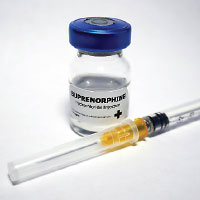Journal Digest: Arbaclofen; Postpartum Depression; LDX; and More
Arbaclofen May Improve ASD-Associated Visual Processing Deficits

People with autism spectrum disorder (ASD) often have problems processing visual stimuli, leading to symptoms such as high sensitivity to flickering lights. A study published in Science Translational Medicine reports that the experimental drug arbaclofen may help restore some of these processing deficits.
“This [finding] has important implications for the development and testing of interventions that target fundamental sensory differences in ASD,” wrote the researchers from King’s College London and colleagues.
The researchers recruited 19 adults with ASD and 25 adults without the disorder for a series of visual stimulus experiments. All the participants were asked to focus on a static image in the presence of both foreground (flickering circles) and background (changing background patterns) interference while wearing EEG devices to measure brain activity. The participants engaged in multiple sessions, each time after randomly taking a placebo pill or 15 mg or 30 mg of arbaclofen, a GABA-B receptor agonist.
When the participants took placebo, the brain activity of the adults without ASD changed as both foreground and background interference increased, as the brain was adapting to different visual demands. In the adults with ASD, however, brain activity remained similar despite the changes in foreground and background interference. Similar results were seen when the participants took 15 mg of arbaclofen.
After taking 30 mg of arbaclofen, however, adults without ASD exhibited no EEG changes in response to interference, whereas the adults with ASD had “typical” brain activity that adjusted in response to interference.
“Sensory processes are … fundamental to ASD, and the current findings open new avenues to encourage examination of pharmacological interventions that specifically target the sensory domain in ASD, possibly through GABA-B receptor,” the investigators wrote.
Huang Q, Pereira AC, Velthuis H, et al. GABA(B) Receptor Modulation of Visual Sensory Processing in Adults With and Without Autism Spectrum Disorder. Sci Transl Med. 2022; 14(626): eabg7859.
Postpartum Depression Linked With Pain During Pregnancy

Several studies have reported that pregnancy-related pain is a risk factor for postpartum depression, but analyses have focused on pain occurring during and/or after delivery. A study in the Journal of Affective Disorders now reports that pain experienced by women as early as the first trimester of pregnancy can increase the risk of postpartum depression.
Investigators at Kochi Medical School in Japan examined data from the Japan Environment and Children’s Study, a nationwide study to assess the impact of the environment on fetal and child development. As part of this study, expectant mothers completed questionnaires on physical pain and depression. The study sample included 84,801 mothers, of whom 11,535 (13.6%) screened positive for postpartum depression one month after delivery.
About 70% and 84% of mothers reported some pain during their first and second/third trimesters, respectively, with a majority experiencing pain across pregnancy. After adjusting for such variables as age, psychosocial factors, and history of psychiatric illness, the investigators found that mothers who experienced pain during the first trimester had a 28% increased risk of postpartum depression compared with women who did not experience pain during pregnancy. Those who experienced pain during the second/third trimester had a 42% increased risk, while those who experienced pain during both periods had a 95% increased risk. The analysis also revealed that the more severe the pain experienced, the greater the risk of postpartum depression.
“These novel findings indicate that severe and persistent prenatal pain is another major predictor for [postpartum depression], in addition to delivery and postnatal pain,” the investigators wrote. “[E]ffective pain management during pregnancy is recommended for preventing [postpartum depression] and for improving the quality of life of pregnant women and their families.”
Shigematsu-Locatelli M, Kawano T, Yasumitsu-Lovell K, et al. Maternal Pain During Pregnancy Dose-Dependently Predicts Postpartum Depression: the Japan Environment and Children’s Study. J Affect Disord. January 14, 2022. Online ahead of print.
LDX Acts Via Satiety, Reward Pathways

Lisdexamfetamine dimesylate (LDX) is the only medication approved by the Food and Drug Administration for the treatment of binge-eating disorder, but little is known about the neural processes that underpin this medication’s efficacy. A study appearing in Translational Psychiatry now reports that LDX may impact cognitive pathways regulating both satiety and reward processing.
Researchers at the University of Birmingham in the United Kingdom and colleagues recruited 22 women with binge-eating symptoms to participate in a placebo-controlled crossover study of LDX’s mood and cognitive effects.
The participants first took either 50 mg of LDX or a placebo pill. After two hours, the participants completed a series of cognitive and emotional tests, including looking at food and non-food images while receiving a functional MRI (fMRI). Following the fMRI, the participants ate lunch (pasta followed by cookies) that was placed on a scale to measure ingestion. During the lunch, the women periodically completed questionnaires on the fullness and pleasantness of their meal. All participants took part in two sessions on two separate days, at least seven days apart.
The researchers found that during each session, the women who took LDX performed better on some attention tasks and impulsivity measures than those who took placebo. Women who took LDX also reported lower ratings for fatty and sugary foods while undergoing fMRI, and this was associated with lower activity in the thalamus (a brain region that processes sensory information).
During lunch, women who took LDX ate less pasta and cookies than those who took placebo. After taking LDX, women also ate pasta more slowly, and found pasta less palatable at the end of the meal (Eating rate and palatability of cookies was not affected by LDX).
“[T]he observed effects of LDX on food intake ... may be related to the actions of the drug to enhance satiety, reduce food-related reward responding when full, and/or increase cognitive control. Novel pharmacotherapies for [binge-eating disorder] might be most effective if they have a broad spectrum of effects on appetite, reward, and cognition,” the researchers wrote.
Schneider E, Martin E, Rotshtein P, et al. The Effects of Lisdexamfetamine Dimesylate on Eating Behaviour and Homeostatic, Reward and Cognitive Processes in Women with Binge-Eating Symptoms: An Experimental Medicine Study. Transl Psychiatry. 2022; 12(1): 9.
Air Quality Improvements Can Lower Dementia Risk in Women

Numerous studies have pointed to poor air quality as a risk factor for dementia. A study in PNAS now suggests that improving air quality in late life can reduce dementia risk.
Investigators at the University of Southern California and colleagues looked at data from the Women’s Health Initiative (WHI) Memory Study —Epidemiology of Cognitive Health Outcomes, an ancillary study of the WHI trials initiated in 1993. In addition to assessing the cognitive outcomes of community-dwelling older women across the United States from 2008 to 2018, the researchers examined data on individual-level outdoor air pollution collected from 1998 to 2012. A total of 2,239 women aged 74 to 92 who did not have dementia at their baseline assessment were included in the analysis. During the follow-up period, 398 of these women developed dementia.
The investigators next used Environmental Protection Agency models to calculate the participants’ 10-year historical exposure to fine particulate matter and nitrogen dioxide (two biomarkers of traffic pollution). After adjusting for demographic and clinical variables, they found that every 25% improvement in air quality over a decade was associated with a 20% reduction in dementia risk—about the same reduction associated with being 2.4 years younger. The reduced dementia risk was about the same regardless of the women’s age, economic status, or location at baseline.
“The observed lower dementia risk associated with improved [air quality] strengthens the hypothesized causal role of late-life exposure to ambient air pollution [in dementia] and its contribution to pathological brain aging,” the investigators wrote.
Wang X, Younan D, Millstein J, et al. Association of Improved Air Quality With Lower Dementia Risk in Older Women. Proc Natl Acad Sci U S A. 2022; 119(2): e2107833119.
Providing Buprenorphine in Jails Found to Reduce Recidivism

Offering buprenorphine to inmates with opioid use disorder (OUD) can reduce the rates of recidivism, according to a study in Drug and Alcohol Dependence.
Investigators at the University of Massachusetts compared two groups of incarcerated adults with OUD: one group received buprenorphine as well as naltrexone in the rural Franklin County Sheriff’s Office (FCSO) in Greenfield, Mass.; the other group at the nearby rural Hampshire County House of Corrections (HCHC) only had access to naltrexone.
The researchers tracked the post-release recidivism (any incarceration, arraignment, or probation violation) of all adults with a diagnosed OUD who exited either county’s jail between January 2015 (Hampshire County) or February 2016 (Franklin County) and April 2019. The sample included 197 adults released from FCSO and 272 from HCHC. Over 93% of the inmates at FCSO with OUD definitively received an opioid medication (primarily buprenorphine) while incarcerated, compared with none of the inmates at HCHC (one was given naltrexone upon release).
Adults released from FCSO experienced statistically less re-arraignment (36% vs. 47%) and re-incarceration (21% vs. 39%) compared with those released from HCHC. There was no significant difference in probation violations.
After adjusting for slight differences in the two inmate groups, the researchers calculated that access to buprenorphine reduced the risk of any recidivism by 32%.
“In addition to the demonstrated reduction in overdose mortality, the current study provides legislators and correctional officials with compelling evidence that [medications for OUD] in jail will reduce recidivism,” the researchers wrote.
Evans EA, Wilson D, Friedmann PD. Recidivism and Mortality After In-jail Buprenorphine Treatment for Opioid Use Disorder. Drug Alcohol Depend. January 4, 2022. Online ahead of print.
Preexisting Cognitive Risk Linked to Long-Term COVID Symptoms

OAdults with preexisting cognitive risk factors, such as hypertension and a history of brain injury, may be more likely to develop persistent post-COVID cognitive symptoms, according to a preliminary study conducted by researchers at the University of California, San Francisco. The findings were published in the Annals of Clinical and Translational Neurology.
The researchers recruited adults who had been infected with COVID-19 but who did not require hospitalization. Of the 32 adults in this group (average age 41 years), 22 adults developed cognitive symptoms such as problems with attention or working memory following infection while 10 did not. The two groups were similar in terms of age, gender, race/ethnicity, and education history. All participants underwent clinical interviews and neuropsychological tests, and 17 (13 with cognitive symptoms and four without cognitive symptoms) provided cerebrospinal fluid (CSF) samples.
Nine of the 22 participants with cognitive symptoms reported that their cognitive symptoms first emerged at least one month after their first COVID-19 symptoms occurred, and this group tended to be younger than those whose cognitive symptoms appeared quickly. The group who experienced cognitive symptoms following COVID-19 had a greater number of preexisting cognitive risk factors than those without cognitive symptoms.
Overall, 10 of 13 of the participants with cognitive symptoms who had CSF analyzed had abnormal levels of some CSF proteins—suggesting potential brain inflammation. None of the people who did not experience cognitive symptoms following COVID-19 had abnormal levels of CSF proteins.
“Future efforts will need to develop objective criteria for cognitive PASC [post-acute sequelae of SARS-CoV-2] to facilitate patient care and clinical research,” the researchers wrote. ■
Apple AC, Oddi A, Peluso MJ, et al. Risk Factors and Abnormal Cerebrospinal Fluid Associate With Cognitive Symptoms After Mild COVID-19. Ann Clin Transl Neurol. January 19, 2022. Online ahead of print.



